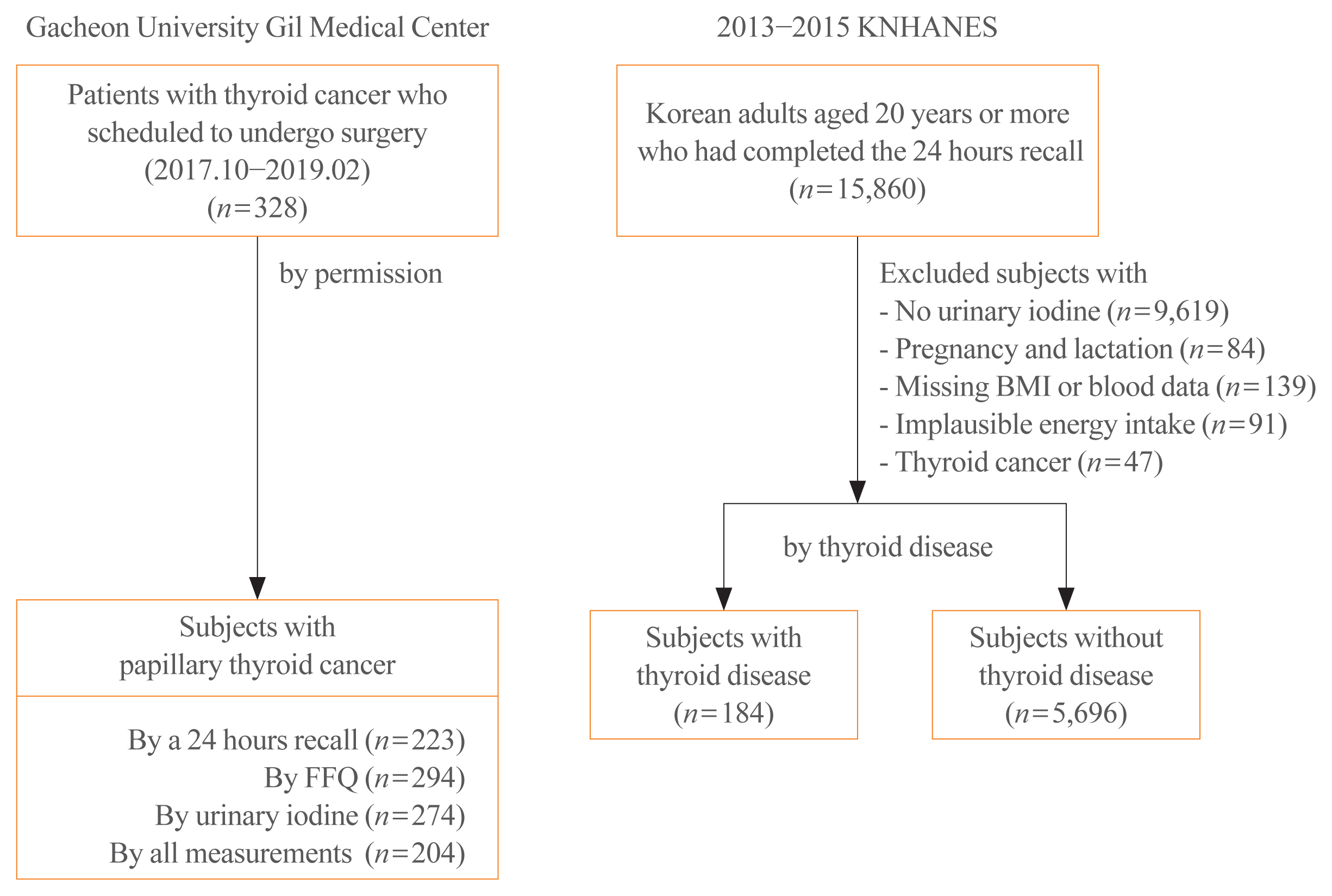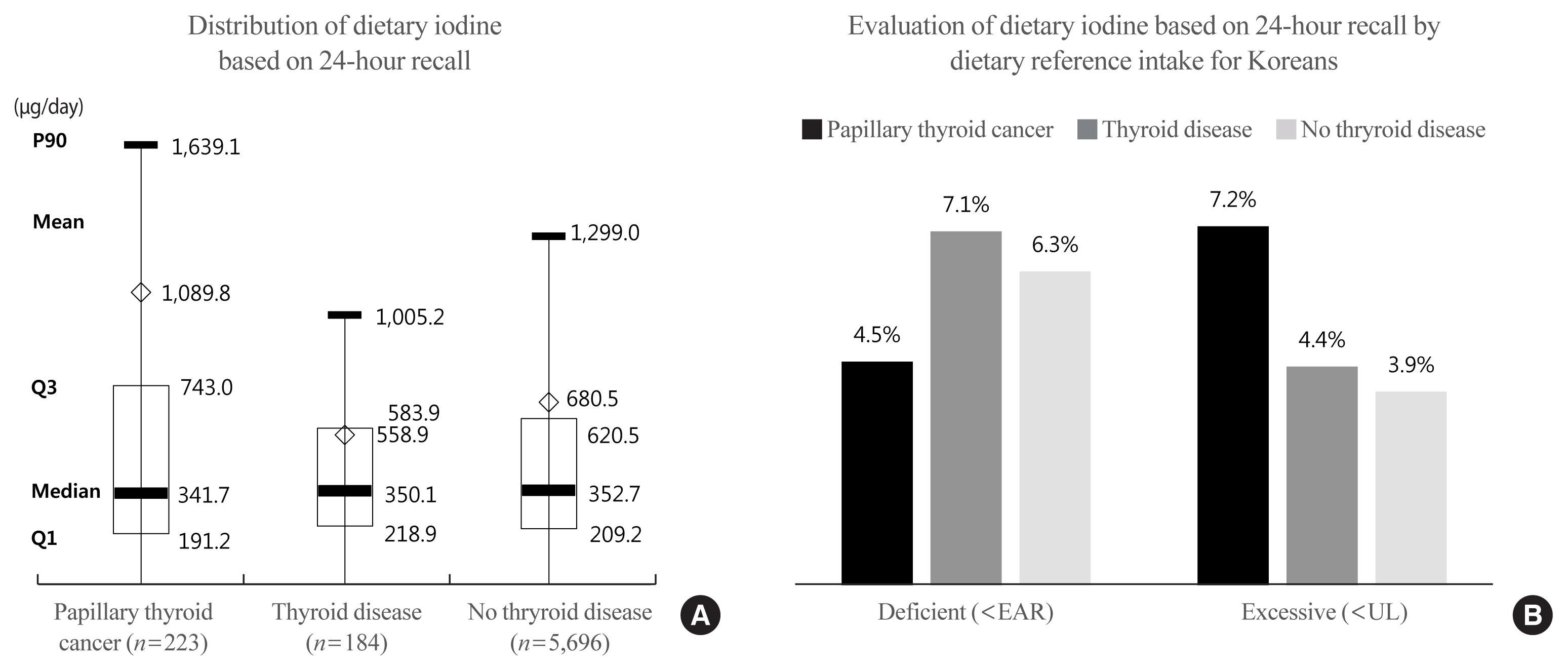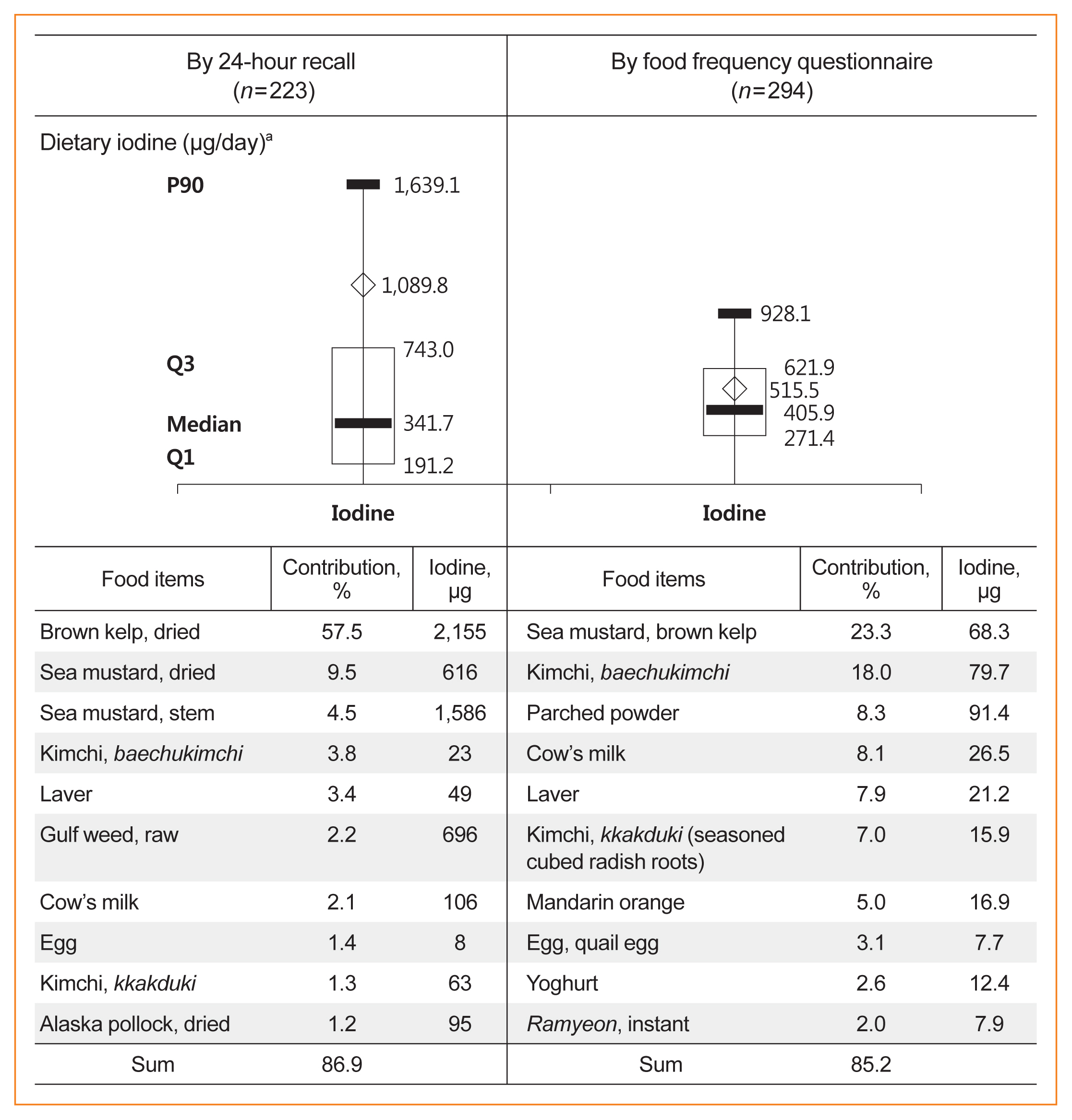Endocrinol Metab.
2021 Jun;36(3):607-618. 10.3803/EnM.2021.1005.
Evaluation of Iodine Status among Korean Patients with Papillary Thyroid Cancer Using Dietary and Urinary Iodine
- Affiliations
-
- 1Department of Food Science & Nutrition, The Catholic University of Korea, Bucheon, Korea
- 2Department of Surgery, Gachon University Gil Medical Center, Gachon University College of Medicine, Incheon, Korea
- KMID: 2517651
- DOI: http://doi.org/10.3803/EnM.2021.1005
Abstract
- Background
Concerns have been raised regarding thyroid disorders caused by excessive iodine in Koreans, who have iodine-rich diets. This study evaluated iodine status using dietary iodine intake and urinary iodine in papillary thyroid cancer (PTC) patients.
Methods
Dietary data of PTC patients were assessed using a 24-hour recall and food frequency questionnaire (FFQ), and urinary iodine concentrations (UICs) were also obtained. To compare the iodine status of PTC patients, Korean adults with or without thyroid disease from the Korea National Health and Nutrition Examination Survey, which had 24-hour recall data and urinary iodine measurements, were analyzed.
Results
The median daily iodine intake by 24-hour recall was 341.7 μg/day in PTC patients, similar to the levels of other Korean adults. Based on UICs, the prevalence of excessive iodine was 54.4% in PTC patients, which was similar to the prevalence among subjects with thyroid disease (55.4%) but slightly higher than that in subjects without thyroid disease (47.7%). Based on dietary iodine by 24-hour recall, the prevalence of excessive iodine intake was 7.2%, which was higher than that among subjects with (4.4%) or without (3.9%) thyroid disease. The dietary iodine intake based on 24-hour recall was closely correlated with the UIC (r=0.4826) in PTC patients, but dietary iodine by FFQ was not significantly correlated with either 24-hour recall or UIC-based dietary iodine.
Conclusion
Excessive iodine intake was more common in PTC patients than in subjects without thyroid disease. Further longitudinal research is necessary to elucidate the role of dietary iodine in PTC.
Keyword
Figure
Reference
-
1. Farebrother J, Zimmermann MB, Andersson M. Excess iodine intake: sources, assessment, and effects on thyroid function. Ann N Y Acad Sci. 2019; 1446:44–65.
Article2. Laurberg P, Jorgensen T, Perrild H, Ovesen L, Knudsen N, Pedersen IB, et al. The Danish investigation on iodine intake and thyroid disease, DanThyr: status and perspectives. Eur J Endocrinol. 2006; 155:219–28.
Article3. Yu X, Fan C, Shan Z, Teng X, Guan H, Li Y, et al. A five-year follow-up study of goiter and thyroid nodules in three regions with different iodine intakes in China. J Endocrinol Invest. 2008; 31:243–50.
Article4. Lee JH, Hwang Y, Song RY, Yi JW, Yu HW, Kim SJ, et al. Relationship between iodine levels and papillary thyroid carcinoma: a systematic review and meta-analysis. Head Neck. 2017; 39:1711–8.
Article5. Kim HI, Oh HK, Park SY, Jang HW, Shin MH, Kim SW, et al. Urinary iodine concentration and thyroid hormones: Korea National Health and Nutrition Examination Survey 2013–2015. Eur J Nutr. 2019; 58:233–40.
Article6. Lee J, Kim JH, Lee SY, Lee JH. Iodine status in Korean preschool children as determined by urinary iodine excretion. Eur J Nutr. 2014; 53:683–8.
Article7. Kim S, Kwon YS, Kim JY, Hong KH, Park YK. Association between iodine nutrition status and thyroid disease-related hormone in Korean adults: Korean National Health and Nutrition Examination Survey VI (2013–2015). Nutrients. 2019; 11:2757.
Article8. Carriquiry AL, Spungen JH, Murphy SP, Pehrsson PR, Dwyer JT, Juan W, et al. Variation in the iodine concentrations of foods: considerations for dietary assessment. Am J Clin Nutr. 2016; 104(Suppl 3):877S–87S.
Article9. Katagiri R, Asakura K, Sasaki S, Hirota N, Notsu A, Miura A, et al. Estimation of habitual iodine intake in Japanese adults using 16 d diet records over four seasons with a newly developed food composition database for iodine. Br J Nutr. 2015; 114:624–34.
Article10. Choi JY, Ju DL, Song Y. Revision of an iodine database for Korean foods and evaluation of dietary iodine and urinary iodine in Korean adults using 2013–2015 Korea National Health and Nutrition Examination Survey. J Nutr Health. 2020; 53:271.
Article11. Vandevijvere S, Lin Y, Moreno-Reyes R, Huybrechts I. Simulation of total dietary iodine intake in Flemish preschool children. Br J Nutr. 2012; 108:527–35.
Article12. Cao LZ, Peng XD, Xie JP, Yang FH, Wen HL, Li S. The relationship between iodine intake and the risk of thyroid cancer: a meta-analysis. Medicine (Baltimore). 2017; 96:e6734.13. Cho YA, Kim J. Dietary factors affecting thyroid cancer risk: a meta-analysis. Nutr Cancer. 2015; 67:811–7.
Article14. Imaeda N, Kuriki K, Fujiwara N, Goto C, Tokudome Y, Tokudome S. Usual dietary intakes of selected trace elements (Zn, Cu, Mn, I, Se, Cr, and Mo) and biotin revealed by a survey of four-season 7-consecutive day weighed dietary records in middle-aged Japanese dietitians. J Nutr Sci Vitaminol (Tokyo). 2013; 59:281–8.
Article15. Combet E, Bouga M, Pan B, Lean ME, Christopher CO. Iodine and pregnancy: a UK cross-sectional survey of dietary intake, knowledge and awareness. Br J Nutr. 2015; 114:108–17.
Article16. Mancini FR, Rajaobelina K, Dow C, Habbal T, Affret A, Balkau B, et al. High iodine dietary intake is associated with type 2 diabetes among women of the E3N-EPIC cohort study. Clin Nutr. 2019; 38:1651–6.
Article17. Combet E, Lean ME. Validation of a short food frequency questionnaire specific for iodine in U.K. females of childbearing age. J Hum Nutr Diet. 2014; 27:599–605.
Article18. Kweon S, Kim Y, Jang MJ, Kim Y, Kim K, Choi S, et al. Data resource profile: the Korea National Health and Nutrition Examination Survey (KNHANES). Int J Epidemiol. 2014; 43:69–77.
Article19. Ahn Y, Kwon E, Shim JE, Park MK, Joo Y, Kimm K, et al. Validation and reproducibility of food frequency questionnaire for Korean genome epidemiologic study. Eur J Clin Nutr. 2007; 61:1435–41.
Article20. The Korean Nutrition Society. Dietary reference intakes for Koreans 2020. Sejong: Ministry of Health and Welfare;2020. p. 399.21. World Health Organization. Assessment of iodine deficieny disorders and monitoring their elimination. Geneva: WHO;2007. p. 98.22. Wang F, Wang Y, Wang L, Wang X, Sun C, Xing M, et al. Strong association of high urinary iodine with thyroid nodule and papillary thyroid cancer. Tumour Biol. 2014; 35:11375–9.
Article23. Huang F, Cong W, Xiao J, Zhou Y, Gong M, Sun J, et al. Association between excessive chronic iodine exposure and the occurrence of papillary thyroid carcinoma. Oncol Lett. 2020; 20:189.
Article24. Zhang L, Fang C, Liu L, Liu X, Fan S, Li J, et al. A case-control study of urinary levels of iodine, perchlorate and thiocyanate and risk of papillary thyroid cancer. Environ Int. 2018; 120:388–93.
Article25. Lee JH, Song RY, Yi JW, Yu HW, Kwon H, Kim SJ, et al. Case-control study of papillary thyroid carcinoma on urinary and dietary iodine status in South Korea. World J Surg. 2018; 42:1424–31.
Article26. Kim HJ, Kim NK, Park HK, Byun DW, Suh K, Yoo MH, et al. Strong association of relatively low and extremely excessive iodine intakes with thyroid cancer in an iodine-replete area. Eur J Nutr. 2017; 56:965–71.
Article27. Gostas DE, Larson-Meyer DE, Yoder HA, Huffman AE, Johnson EC. Dietary relationship with 24 h urinary iodine concentrations of young adults in the mountain west region of the United States. Nutrients. 2020; 12:121.
Article28. Ning P, Ren Q, Teng D, Zhang Z, Lv X, Meng S, et al. Current iodine nutrition status and prevalence of thyroid disorders in Tibetan adults in an oxygen-deficient plateau, Tibet, China: a population-based study. Thyroid. 2020; 30:759–66.
Article29. Katagiri R, Asakura K, Uechi K, Masayasu S, Sasaki S. Iodine excretion in 24-hour urine collection and its dietary determinants in healthy Japanese adults. J Epidemiol. 2016; 26:613–21.
Article30. Michikawa T, Inoue M, Shimazu T, Sawada N, Iwasaki M, Sasazuki S, et al. Seaweed consumption and the risk of thyroid cancer in women: the Japan Public Health Center-based Prospective Study. Eur J Cancer Prev. 2012; 21:254–60.31. Wang C, Yatsuya H, Li Y, Ota A, Tamakoshi K, Fujino Y, et al. Prospective study of seaweed consumption and thyroid cancer incidence in women: the Japan collaborative cohort study. Eur J Cancer Prev. 2016; 25:239–45.
- Full Text Links
- Actions
-
Cited
- CITED
-
- Close
- Share
- Similar articles
-
- Dietary iodine intake and urinary iodine excretion in patients with thyroid diseases
- Patient Preparation and Special Consideration before Radioactive Iodine Therapy
- A Study on the Urinary Iodine Excretion in Normal subjects and Patients with Thyroid disease
- Low Iodine Diet for Preparation for Radioactive Iodine Therapy in Differentiated Thyroid Carcinoma in Korea
- Iodine and thyroid function






